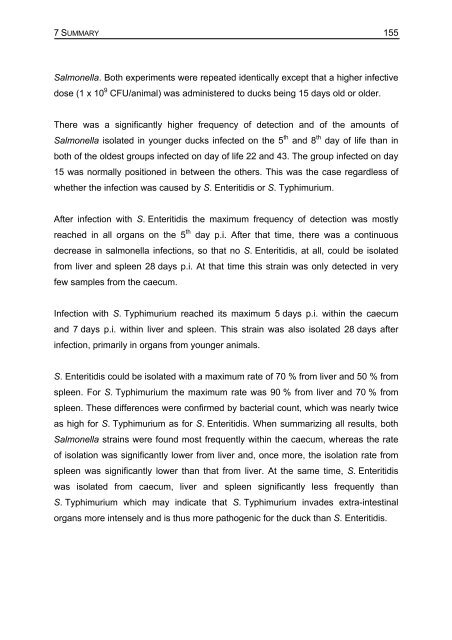Bibliografische Informationen der Deutschen - TiHo Bibliothek elib ...
Bibliografische Informationen der Deutschen - TiHo Bibliothek elib ...
Bibliografische Informationen der Deutschen - TiHo Bibliothek elib ...
Sie wollen auch ein ePaper? Erhöhen Sie die Reichweite Ihrer Titel.
YUMPU macht aus Druck-PDFs automatisch weboptimierte ePaper, die Google liebt.
7 SUMMARY 155<br />
Salmonella. Both experiments were repeated identically except that a higher infective<br />
dose (1 x 10 9 CFU/animal) was administered to ducks being 15 days old or ol<strong>der</strong>.<br />
There was a significantly higher frequency of detection and of the amounts of<br />
Salmonella isolated in younger ducks infected on the 5 th and 8 th day of life than in<br />
both of the oldest groups infected on day of life 22 and 43. The group infected on day<br />
15 was normally positioned in between the others. This was the case regardless of<br />
whether the infection was caused by S. Enteritidis or S. Typhimurium.<br />
After infection with S. Enteritidis the maximum frequency of detection was mostly<br />
reached in all organs on the 5 th day p.i. After that time, there was a continuous<br />
decrease in salmonella infections, so that no S. Enteritidis, at all, could be isolated<br />
from liver and spleen 28 days p.i. At that time this strain was only detected in very<br />
few samples from the caecum.<br />
Infection with S. Typhimurium reached its maximum 5 days p.i. within the caecum<br />
and 7 days p.i. within liver and spleen. This strain was also isolated 28 days after<br />
infection, primarily in organs from younger animals.<br />
S. Enteritidis could be isolated with a maximum rate of 70 % from liver and 50 % from<br />
spleen. For S. Typhimurium the maximum rate was 90 % from liver and 70 % from<br />
spleen. These differences were confirmed by bacterial count, which was nearly twice<br />
as high for S. Typhimurium as for S. Enteritidis. When summarizing all results, both<br />
Salmonella strains were found most frequently within the caecum, whereas the rate<br />
of isolation was significantly lower from liver and, once more, the isolation rate from<br />
spleen was significantly lower than that from liver. At the same time, S. Enteritidis<br />
was isolated from caecum, liver and spleen significantly less frequently than<br />
S. Typhimurium which may indicate that S. Typhimurium invades extra-intestinal<br />
organs more intensely and is thus more pathogenic for the duck than S. Enteritidis.










![Tmnsudation.] - TiHo Bibliothek elib](https://img.yumpu.com/23369022/1/174x260/tmnsudation-tiho-bibliothek-elib.jpg?quality=85)






